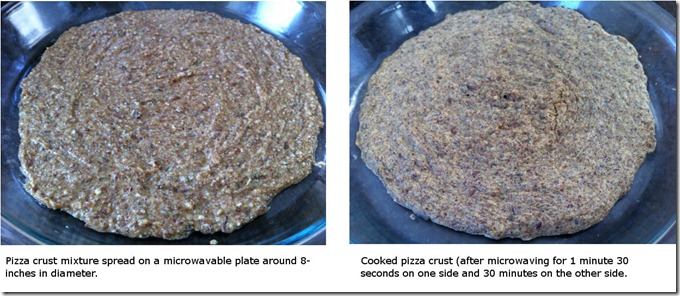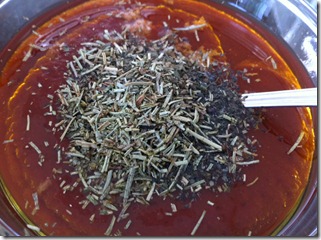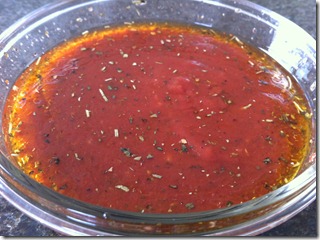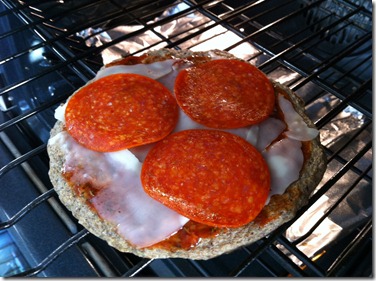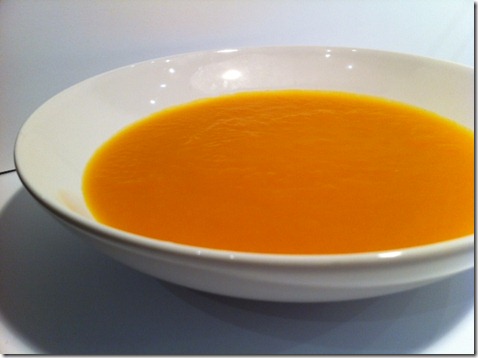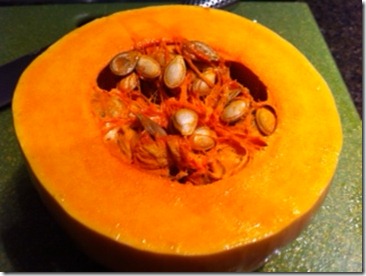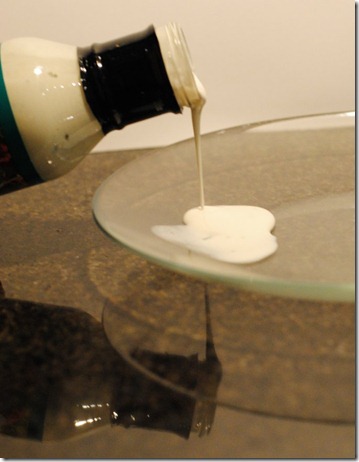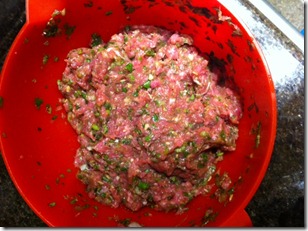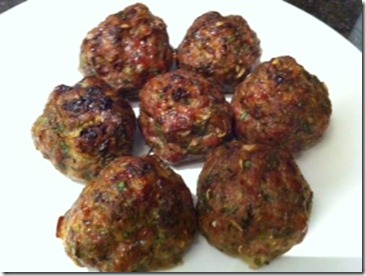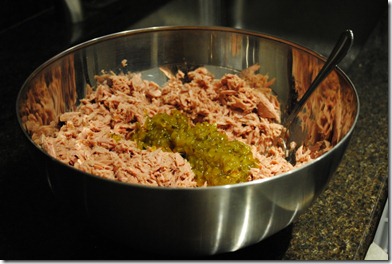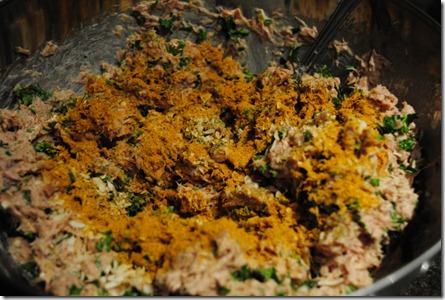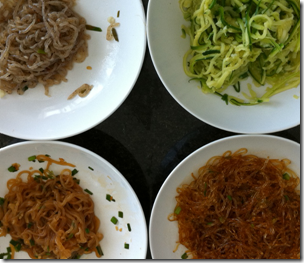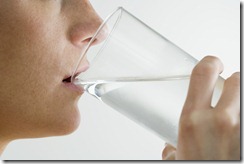Low Carb Pizza
| Low Carb Pizza |
- 3 tablespoons of flax meal (you can make your own by grinding flax seeds in a blender or coffee grinder)
- 2 tablespoons of parmesan cheese
- 1/4 teaspoon of baking powder
- 1 egg
- 2 teaspoons of water
- 1 teaspoon of olive oil
- 1/4 teaspoon of garlic powder
- 1/4 teaspoon of onion powder
- 1 teaspoon of Italian seasoning (or just throw in a bit of basil, oregano, rosemary, thyme, and marjoram or whatever you have handy!)
- 1/2 teaspoon of salt
- Crust:
- Mix all the ingredients together in a bowl until there are no lumps of flax meal or parmesan cheese.
- Grease a microwavable plate that’s larger than 8-inches in diameter (i.e., most dinner plates) with some olive oil (using a paper towel to smudge it around the plate) or use a spray.
- Scoop mixture onto a plate. Spread the mixture in a circular motion using the back of a tablespoon until you create a flat disc around 8-inches in diameter. Make sure the dough isn’t broken in places as you don’t want holes in your pizza crust!
- Microwave for 1 minute 30 seconds on high. Flip it over carefully using a spatula and microwave on high for another 30 seconds.
- If you want the crust to be harder, then you can fry it. Just put a teaspoon of olive oil into a flat frying pan and fry each side for 2 minutes or until you think it’s hard enough. I’m lazy and am ok with a soft crust for the pizza.
- To cook the pizza (after putting sauce and toppings on – see below for those), heat the oven to 350F and bake for 15 minutes.
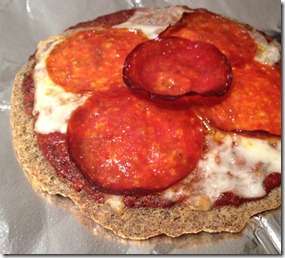 I always thought low carb pizza was some sort of myth (closely akin to unicorns and the Yeti) until I saw this recipe on Linda’s genaw.com. This recipe (which is below) makes individual 8-inch pizzas and is simple to make. The crust is made from a mixture of flax meal and parmesan cheese, which you cook in the microwave in just 2 minutes! Then for the sauce, you can go really easy and just use store-bought pizza sauce or make your own homemade pizza sauce using the recipe below (which just involves mixing some ingredients together and no cooking). I really like the sauce and recommend making it (it has very few carbs and tastes great). The recipe for the sauce makes a fair amount of sauce – enough for 8-10 pizzas (I found the recipe on allrecipes.com – it looked so simple to make and got great reviews from nearly 300 reviewers).
I always thought low carb pizza was some sort of myth (closely akin to unicorns and the Yeti) until I saw this recipe on Linda’s genaw.com. This recipe (which is below) makes individual 8-inch pizzas and is simple to make. The crust is made from a mixture of flax meal and parmesan cheese, which you cook in the microwave in just 2 minutes! Then for the sauce, you can go really easy and just use store-bought pizza sauce or make your own homemade pizza sauce using the recipe below (which just involves mixing some ingredients together and no cooking). I really like the sauce and recommend making it (it has very few carbs and tastes great). The recipe for the sauce makes a fair amount of sauce – enough for 8-10 pizzas (I found the recipe on allrecipes.com – it looked so simple to make and got great reviews from nearly 300 reviewers).
Ingredients to make 1 crust :
- 3 tablespoons of flax meal (you can make your own by grinding flax seeds in a blender or coffee grinder)
- 2 tablespoons of parmesan cheese
- 1/4 teaspoon of baking powder
- 1 egg
- 2 teaspoons of water
- 1 teaspoon of olive oil
- OPTIONAL INGREDIENTS
- 1/4 teaspoon of garlic powder
- 1/4 teaspoon of onion powder
- 1 teaspoon of Italian seasoning (or just throw in a bit of basil, oregano, rosemary, thyme, and marjoram or whatever you have handy!)
- 1/2 teaspoon of salt
Directions:
- Mix all the ingredients together in a bowl until there are no lumps of flax meal or parmesan cheese.
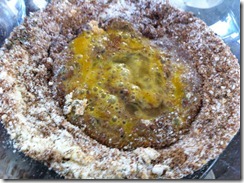
- Grease a microwavable plate that’s larger than 8-inches in diameter (i.e., most dinner plates) with some olive oil (using a paper towel to smudge it around the plate) or use a spray.
- Scoop mixture onto a plate. Spread the mixture in a circular motion using the back of a tablespoon until you create a flat disc around 8-inches in diameter. Make sure the dough isn’t broken in places as you don’t want holes in your pizza crust!
- Microwave for 1 minute 30 seconds on high. Flip it over carefully using a spatula and microwave on high for another 30 seconds.
- If you want the crust to be harder, then you can fry it. Just put a teaspoon of olive oil into a flat frying pan and fry each side for 2 minutes or until you think it’s hard enough. I’m lazy and am ok with a soft crust for the pizza.
- To cook the pizza (after putting sauce and toppings on – see below for those), heat the oven to 350F and bake for 15 minutes.
Ingredients to Make Pizza Sauce (good for 8-10 pizzas):
- 1 can (6oz) of tomato paste
- 1 and 1/2 cups of water
- 1/3 cup of olive oil
- 2 cloves garlic, minced
- 1/2 tablespoon of dried oregano
- 1/2 tablespoon of dried basil
- 1/2 tablespoon of dried rosemary (crushed – I just used my fingers to crumble some)
- Alternatively (instead of oregano, basil and rosemary, you can just put 1 and 1/2 tablespoons of Italian seasoning).
- 2 teaspoon of salt (0r to taste)
- 1/2 teaspoon of pepper (or to taste)
Directions:
- Mix everything together well. Best used after it’s been left to stand for a few hours, but it tastes pretty good even if you use it straight away.
The photos below show me about to mix all the ingredients and after it’s mixed.
Toppings:
I put a few slices of mozzarella and pepperoni on top, but you’re welcome to pick your own toppings. Here’s one last photo, which shows the pizza about to go into the oven.
Butternut Squash Soup
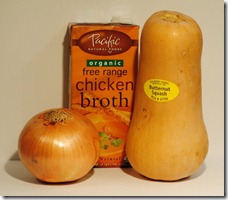 Winter has most definitely set in again (unless you’re in the southern hemisphere, in which case, I truly envy you right now!). This weekend has been literally freezing in New York, so I decided to keep warm with some butternut squash soup, which is both delicious and easy to make!
Winter has most definitely set in again (unless you’re in the southern hemisphere, in which case, I truly envy you right now!). This weekend has been literally freezing in New York, so I decided to keep warm with some butternut squash soup, which is both delicious and easy to make!
Those 3 ingredients you see pictured on the left are pretty much all you need! (In addition, a blender, a food processor, or an immersion blender – which is the best one to use – is also crucial to create that smooth soup texture.)
Ingredients (4 servings)
- 1 chopped onion (I used half of the one in the photo as it was a really large onion)
- 32oz (4 cups) chicken broth
- 1 butternut squash
- 1 tablespoon of coconut oil (or dab of butter)
- salt to taste
- nutmeg and pepper (optional)
Directions
- Chop the onion (no need to chop it particularly finely).
- Add 1 tablespoon of coconut oil (or butter) to a large pot (large enough for more than 8 cups of liquid) and add the chopped onions. Sauté the onions on low heat until they turn transparent (5-10minutes).
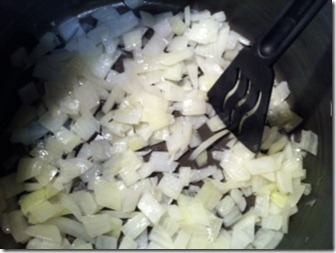
- While the onions are cooking, chop up the butternut squash. I cut it into 1-inch thick slices and then take off the skin by chopping it off (see photo below). Then I cut the squash into roughly 1-inch cubes.
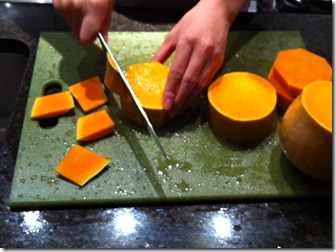
- When the onions turn transparent (the onions have turned transparent in the photo below), pour in the 32 ounces of chicken broth. Then add the chopped squash and simmer on a medium heat for 1 hour.
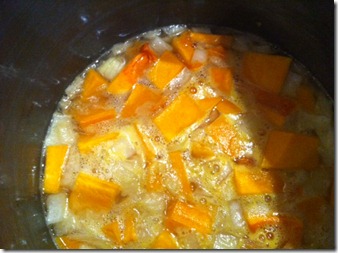
- Now comes the hard part. If you have an immersion blender, then stick it into the pot and puree the cooked veggies to create the soup. (Try to keep the end of the stick immersed in the soup to prevent too much splashing.) If you don’t have an immersion blender, then you’ll need to take the softened veggies (squash and onions) out of the pot, without the liquid, and place it into a blender or food processor to puree.
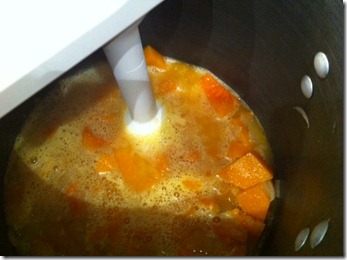
- Once pureed, season with salt. Try a bit of the soup to see how much salt you want. If the butternut squash you used was very ripe, then your soup may be sweeter and therefore you might want less salt. You can also add pepper and nutmeg.
- Cook for another half hour and serve.
Added Bonus: When you were cutting up the butternut squash, you probably noticed all those seeds inside of the squash. If you scoop these out (I use my hands) and wash them clean, you can then cook them for 30min in the oven at 350F on a piece of aluminum foil and eat them whole as a crispy snack.
If you don’t like butternut squash, you can substitute sweet potatoes (or Japanese yams) or pumpkin, or you can mix it up. I’ve made the soup before with a butternut squash, 2 Japanese yams and a can of pumpkin puree (in which case I needed 64oz of chicken broth).
Note: butternut squash is one of the more starchy squashes (1 cup = 18g net carbs), and it isn’t permitted on the Atkins diet until the later stages. It is however permitted on primal and paleo diets, and many low-carbers are ok with eating butternut squash, yams, and pumpkins as long as you don’t go overboard!
Zero Calorie Salad Dressings–Reviews
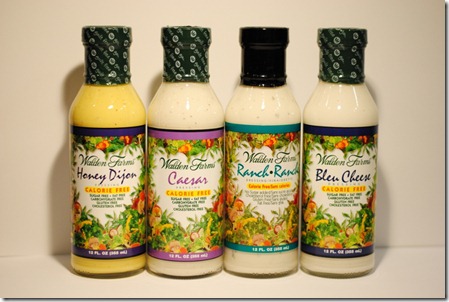 When I first heard about Walden Farm’s calorie-free salad dressings, my reaction was immediately…is that possible?? Previously, I had thought the only possible low-carb low-calorie options were salt and red wine vinegar (balsamic vinegar has sugar in it). However, after trying their calorie-free syrup (pretty decent) with my coconut flour pancakes and their BBQ sauce with my pulled pork, I thought it’d give it a go with their range of salad dressings.
When I first heard about Walden Farm’s calorie-free salad dressings, my reaction was immediately…is that possible?? Previously, I had thought the only possible low-carb low-calorie options were salt and red wine vinegar (balsamic vinegar has sugar in it). However, after trying their calorie-free syrup (pretty decent) with my coconut flour pancakes and their BBQ sauce with my pulled pork, I thought it’d give it a go with their range of salad dressings.
The Flavors
Walden Farm’s website lists a healthy selection of 20 different flavors, ranging from your common Caesar dressing to you more exotic Chipotle Ranch. However, my local Food Emporium (you can search their website for where their sauces are sold or buy it online at stores like Amazon) only carried 4 different flavors (at $4.19 each).
Review 1 – Walden Farm Ranch Flavor
If white paint were a salad dressing, then this is how it would look when poured out of the bottle:
Unfortunately, the smell also resembled paint, with a tinge of ranch and a heck of a lot of vinegar. It honestly made my stomach turn, and I wasn’t sure if I could eat it at all. But I had a salad all lined up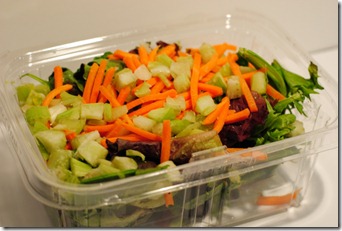 , which had come with a 220 calorie packet of Newman’s ranch dressing that was already in the trash. I had to brave the smell – maybe the taste would be better? I dipped a few leaves into the white liquid, held my breath, and placed the “food” into my mouth. My first thought was “EWWWW” followed by it tastes like paint, followed by paint thinned with vinegar. But, by the time I had finished chewing the mouthful, it did taste a bit like ranch and was almost edible. I guess if you’re expecting a creamy ranch dressing, think again! A better description would probably be ranch-flavored vinaigrette (if you’re trying to be nice). I personally would never eat this again (and I hope you all appreciate what I went through to review this!), but perhaps the point that many Amazon reviewers make is worth bearing in mind here – it is zero calories….you obviously can’t expect it to taste like actual ranch salad dressing. With that thought in mind, I moved onto the Honey Dijon flavor.
, which had come with a 220 calorie packet of Newman’s ranch dressing that was already in the trash. I had to brave the smell – maybe the taste would be better? I dipped a few leaves into the white liquid, held my breath, and placed the “food” into my mouth. My first thought was “EWWWW” followed by it tastes like paint, followed by paint thinned with vinegar. But, by the time I had finished chewing the mouthful, it did taste a bit like ranch and was almost edible. I guess if you’re expecting a creamy ranch dressing, think again! A better description would probably be ranch-flavored vinaigrette (if you’re trying to be nice). I personally would never eat this again (and I hope you all appreciate what I went through to review this!), but perhaps the point that many Amazon reviewers make is worth bearing in mind here – it is zero calories….you obviously can’t expect it to taste like actual ranch salad dressing. With that thought in mind, I moved onto the Honey Dijon flavor.
Review 2 – Walden Farm Honey Dijon Flavor
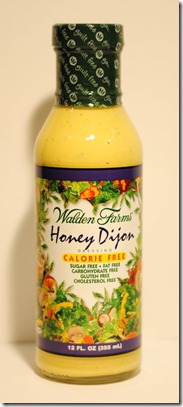 Whereas the ranch dressing was thin and liquidy, this one was actually pretty thick. It was a promising start – at least it looked like honey mustard dressing! Then I smelled it. Oh dear. I felt my stomach churn. It smelled like honey mustard flavored rubber. The rubber smell was quite overwhelming, and again, I didn’t want to put the food into my mouth. The taste was just as bad. I know that I taste food pretty strongly (I can often detect flavors and smells that other people miss), but this has to be obvious to everyone, right? Reading the Amazon reviews of all the people who simply “love” this product shocks me! I think I have to agree with the person who titled their review “Yuck.”
Whereas the ranch dressing was thin and liquidy, this one was actually pretty thick. It was a promising start – at least it looked like honey mustard dressing! Then I smelled it. Oh dear. I felt my stomach churn. It smelled like honey mustard flavored rubber. The rubber smell was quite overwhelming, and again, I didn’t want to put the food into my mouth. The taste was just as bad. I know that I taste food pretty strongly (I can often detect flavors and smells that other people miss), but this has to be obvious to everyone, right? Reading the Amazon reviews of all the people who simply “love” this product shocks me! I think I have to agree with the person who titled their review “Yuck.”
An hour later, I wanted to give the salad dressing a second chance, and I mixed a tiny amount in with some salad. I thought that maybe if a small amount of the dressing was well dispersed throughout the salad, then it would taste a bit better. Just the smell almost stopped me from ever getting close to that thing again! But, I for the sake of this blog, I held my breath and put it into my mouth. I am happy to admit that I was able to swallow the 2 pieces of leaves. The dressing still tasted like rubber to me, but the taste wasn’t so strong due to the mixing. But, at this point, I think I might just have the salad without any dressing.
Review 3 – Walden Farm Blue Cheese Flavor
 As if I wasn’t already worried about trying my third bottle of Walden Farm’s salad dressing after my awful (almost-puking) experiences with the first two bottles, I then read a review of the Blue Cheese flavor, described in one review as tasting and smelling like “white glue.” After trying the dressing, I can understand the “white glue” description. It definitely looked like white glue, and I have to admit it did smell a bit like glue too! However, this one seemed to taste more like the advertised flavor than the others. I definitely tasted blue cheese flavor, the texture was nice and thick (if you can get rid of the white glue imagery), and it wasn’t as vinegary as the previous two. The downside of course is that it still doesn’t taste like real dressing. There’s some odd taste to all their dressings (petroleum?) that sadly just disgusts me.
As if I wasn’t already worried about trying my third bottle of Walden Farm’s salad dressing after my awful (almost-puking) experiences with the first two bottles, I then read a review of the Blue Cheese flavor, described in one review as tasting and smelling like “white glue.” After trying the dressing, I can understand the “white glue” description. It definitely looked like white glue, and I have to admit it did smell a bit like glue too! However, this one seemed to taste more like the advertised flavor than the others. I definitely tasted blue cheese flavor, the texture was nice and thick (if you can get rid of the white glue imagery), and it wasn’t as vinegary as the previous two. The downside of course is that it still doesn’t taste like real dressing. There’s some odd taste to all their dressings (petroleum?) that sadly just disgusts me.
Review 4 – Walden Farm Caesar Flavor
I feel like I’ve pretty much run out of things to say about these salad dressings. They all taste slightly different, but they all seem pretty inedible to me. The Caesar flavored one smells kind of like actual Caesar dressing and looks like it, but doesn’t taste like it. It has a salty glue taste (different to blue cheese flavor).
Review 5 – Walden Farm Raspberry Vinaigrette Flavor
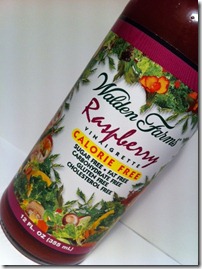 I found this at a different Food Emporium, and so I thought I’d add it to the list. This seemed to have received the most positive reviews on Amazon, and so I was almost eager to try it despite everything else! It smelled and looked like a raspberry vinaigrette (as opposed to paint or glue) – so kudos for that! The taste was ok – I could still taste something slightly weird (again resembling petroleum or greasy oil) that they must put into all their dressings to make them calorie free, but the raspberry and vinegar tastes were also strong, which made it much better than the others. So, overall, I would say that this was the best one, although the claim of being edible is barely anything to celebrate about considering that most vinaigrette dressings are very low in calories (often under 50 calories for 2 tablespoons and with very low carbs and fat).
I found this at a different Food Emporium, and so I thought I’d add it to the list. This seemed to have received the most positive reviews on Amazon, and so I was almost eager to try it despite everything else! It smelled and looked like a raspberry vinaigrette (as opposed to paint or glue) – so kudos for that! The taste was ok – I could still taste something slightly weird (again resembling petroleum or greasy oil) that they must put into all their dressings to make them calorie free, but the raspberry and vinegar tastes were also strong, which made it much better than the others. So, overall, I would say that this was the best one, although the claim of being edible is barely anything to celebrate about considering that most vinaigrette dressings are very low in calories (often under 50 calories for 2 tablespoons and with very low carbs and fat).
Conclusion
If you’ve read what I’ve written above, then you’re probably not all that tempted. However, I have to say that although I have been severely disappointed by these 5 salad dressings from Walden Farms, I do enjoy several of their other products (their pancake syrup and their BBQ sauce) and am very amazed by how they’re able to suck calories out of everything!
Spaghetti and Meatballs
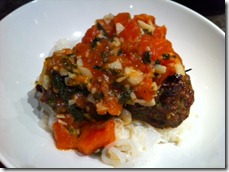 Following up on my low carb pasta post a few months ago, here’s a recipe for a nice low carb meal of spaghetti and meatballs (using shirataki or zucchini noodles). I’d start by making the meatballs (you can make these in advance and then heat them up later). Everything is freshly made except for the shirataki spaghetti, which you easily purchase at Wholefoods or at various supermarkets (most Korean supermarkets sell a variety of them).
Following up on my low carb pasta post a few months ago, here’s a recipe for a nice low carb meal of spaghetti and meatballs (using shirataki or zucchini noodles). I’d start by making the meatballs (you can make these in advance and then heat them up later). Everything is freshly made except for the shirataki spaghetti, which you easily purchase at Wholefoods or at various supermarkets (most Korean supermarkets sell a variety of them).
Meatballs: Ingredients (makes 16-20 meatballs)
- 2lbs pork tenderloin or other lean cut of pork minced or beef or turkey or whatever type of meat you want to use in a food processor (you can buy ground meat, but I prefer to grind my own, since I then know exactly what is going into it)
- 1 cup chopped green onions
- 2 eggs, beaten (this holds the meatballs together)
- 2 tablespoons of garlic powder (or granulated garlic)
- 3 tablespoons of salt
- (Optional) 2 tablespoons of thyme
- (Optional) 2 tablespoons of fennel seeds (I particularly like to use fennel seeds with beef, but they add a lot of flavor with all meats)
- Preheat oven to 350F.
- Beat the eggs and food process the pork so that it’s minced.
- Mix all the ingredients together in a large bowl (I use my hands to do the mixing).
- Shape meatballs with your hands into 1 to 1.5 inch diameter balls (size of a golfball or a little bit bigger), and place them on a non-stick baking tray (no need to grease it). It makes around 16-20 meatballs, depending on how big you make them.
- Put it in the oven and cook for 45 minutes (ovens and sizes of the meatballs can differ and so the cooking time can vary – I would cut one in half to make sure the meat is cooked all the way through).
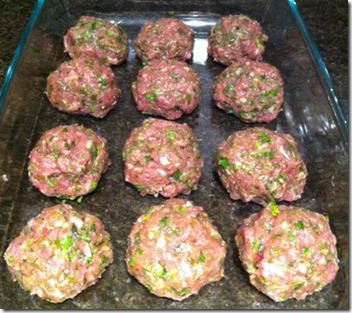
- (Optional) You can brown the meatballs a little by putting them under the broiler for 2 minutes after they’re cooked.
Tomato Sauce: Ingredients (makes 2 servings)
- 1 tablespoon olive oil
- 8 cloves of garlic, minced
- 1/4 cup of chopped basil
- 3 tomatoes, peeled, seeded and diced (I would recommend using the serrated peeler to peel the tomatoes – the pack of 3 peels also comes with a julienne peeler, which is perfect for making zucchini noodles)
- 1/4 cup white wine
- 1/2 cup chicken broth
- salt and pepper to taste (I put in 1.5 tablespoons of salt and a pinch of pepper)
Tomato Sauce: Directions
- Place the olive oil in a large frying pan at medium temperature.
- Put the minced garlic into the oil and fry for 5 minutes without browning it.
- Add the tomatoes, basil and cook for another 2 minutes.
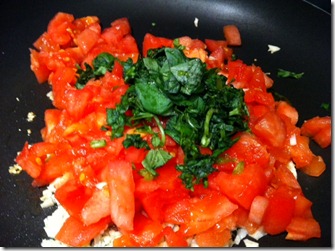
- Add the white wine and the chicken broth and cook for around 10-15 minutes on medium heat (so that it’s simmering) until the sauce is less liquid-y.
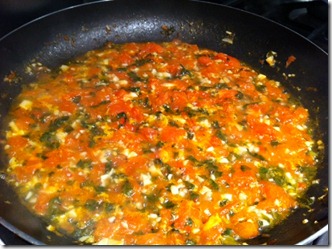
Putting It All Together:
If you’re making zucchini noodles, then you should use a julienne peeler to create the noodles (see low carb pasta post for directions) and then cook the zucchini noodles for 30 seconds on high in the microwave. If you’re planning to use Shirataki (miracle) noodles, then rinse them in cold water and then place them in the microwave for 30 seconds on high to get rid of any excess water. Since both types of pasta are pretty much carb-less and calorie-less, you can pretty much use as much as you want (I recommend 1 zucchini per serving or 1 packet of Shirataki noodles per serving just so you don’t run out of sauce).
Place the pasta on the bottom of a bowl, place 3 meatballs on top, and then pour the sauce onto it.
I calculated each meatball at around 90 calories (for 1.5inch diameter pork meatballs) and 130 calories for each serving of sauce. So for a bowl of 3 meatballs plus the sauce and pasta, it’s around 400 calories. The meatballs have negligible carbs and each serving of sauce has around 4g net carbs (mostly from the garlic and tomatoes). All-Paleo for those of you who care.
Tuna Fish Salad
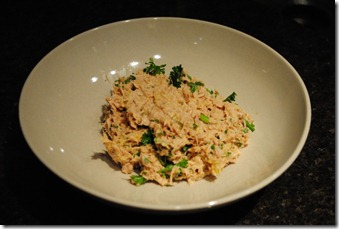 I used to hate tuna fish, and even now I still don’t eat much tuna fish, despite the fact that I generally love seafood. I find tuna fish dry and odd tasting, so the only way I’ll eat tuna fish is in the tuna salad pictured to the left. It’s based on a recipe that I found on allrecipes.com (Barbie’s Tuna Salad), but I’ve modified it slightly to lower the calories and make it taste even better. I use light mayo (Smart Balance, which is low fat and low calorie), less sweet pickle relish and no parmesan cheese (I couldn’t taste it at all!) to cut down on the calories. I also put in less dill and more curry powder than the original recipe calls for (my version is below, of course). All in all, it’s a delicious tuna salad that’s full of protein, is low in carbs, and is relatively low in calories. I make it by the bucket load, so that I have enough to eat for at least a week – Costco sells tuna in 5lb tins, and each tin makes a huge mixing bowl-full that takes me around a week to finish eating.
I used to hate tuna fish, and even now I still don’t eat much tuna fish, despite the fact that I generally love seafood. I find tuna fish dry and odd tasting, so the only way I’ll eat tuna fish is in the tuna salad pictured to the left. It’s based on a recipe that I found on allrecipes.com (Barbie’s Tuna Salad), but I’ve modified it slightly to lower the calories and make it taste even better. I use light mayo (Smart Balance, which is low fat and low calorie), less sweet pickle relish and no parmesan cheese (I couldn’t taste it at all!) to cut down on the calories. I also put in less dill and more curry powder than the original recipe calls for (my version is below, of course). All in all, it’s a delicious tuna salad that’s full of protein, is low in carbs, and is relatively low in calories. I make it by the bucket load, so that I have enough to eat for at least a week – Costco sells tuna in 5lb tins, and each tin makes a huge mixing bowl-full that takes me around a week to finish eating.
Here’s my recipe:
Ingredients:
- One 5lb can (or around ten 7-ounce cans or fourteen 5-ounce cans) of tuna in water (I use the chunk light tuna as I find the white tuna to be too dry) – drain the tuna and flake it thoroughly with a fork
- 1 and 1/4 cups of light mayo (I use Smart Balance Plus Omega)
- 10 tablespoons of sweet pickle relish (this does have some sugar in it, but makes the tuna salad taste so much better!!) I’ve tried substituting this for zero-sugar pickle relish or just omitting it altogether, but the recipe just doesn’t work without it.
- 3 tablespoons dried onion flakes (this gives the tuna fish a bit of a crunchy texture)
- 2 and 1/2 tablespoons of curry powder (this is absolutely key in this recipe, but don’t worry – it doesn’t make it taste like curry…it just gives it that hint of curry flavor, which adds so much more dimension and deliciousness to this tuna salad)
- 1 cup of freshly chopped parsley (you can chop it by hand or in the food processor for a more thorough chop) – the original recipe calls for dried parsley, which you can’t really taste, and so I prefer to use fresh parsley
- (Optional) 3 tablespoons of dried dill weed (I don’t really like the taste of dill, and luckily you can’t really taste it the tuna salad, but if you prefer more of a dill taste, you can decrease the amount of parsley and increase the amount of dill or use fresh dill and dried parsley)
- (Optional) 2 tablespoons of granulated garlic (or garlic powder) – it adds just a bit of subtle flavor
Directions:
This is the simple part – just put everything in a large bowl and mix well (make sure all the tuna is well flaked so that the flavors can mix in with it).
This takes around 20 minutes to prepare. I would say it makes around ten 8-oz servings, and each serving contains around 250 calories.
You can obviously scale the recipe down if you don’t want to make so much tuna in one go, but just be careful to do the calculations correctly.
A Carb-Calorie Catharsis: How to Stay Full while Shedding Fat
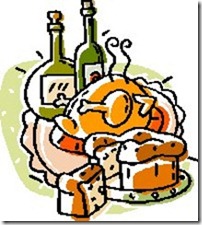 It’s holiday season once again, which is generally a good thing. Unfortunately, much of what I do during holiday season is eat, get a little fatter, and then eat some more. Evolutionarily, this was probably a good thing…our ancestors likely needed to eat more during the autumn so that they could store up fat to make it through the harsh winter when food would be less plentiful.
It’s holiday season once again, which is generally a good thing. Unfortunately, much of what I do during holiday season is eat, get a little fatter, and then eat some more. Evolutionarily, this was probably a good thing…our ancestors likely needed to eat more during the autumn so that they could store up fat to make it through the harsh winter when food would be less plentiful.
I, however, never run out of food. In fact, all I seem to lack in winter is the will to go outside when it’s cold. Thus, I simply spend more time eating in my nice warm apartment and less time doing any form of exercise. Thus, in addition to just staying healthy, I think it’s time for me to shed some fat!
I HATE Counting Calories
But when trying to lose fat, it’s the most efficient way.
I remember quite vividly some rather poor attempts on my part (when I was younger) at calorie-counting diets, and they’re not pleasant memories. The fact of the matter is that many major diets are based on calorie counting (think Weight-Watchers), and for at least some good reason: calories matter if you want to lose fat! I’m not saying that nothing else makes any difference, but the simple truth is that humans only lose weight when their bodies expend more calories than they ingest. You can change multiple parts of this equation (food intake, food absorption, metabolic rate, etc.), but calories will still matter. How then, can I go about counting calories without reliving the painful diet experiences of holidays past?
I think the answer lies in the primary failure of most low calorie diets, namely that people are almost always hungry when counting calories. And those of you who know me know that I’m not pleasant to be around when I’m hungry. So why do most low-calorie diets make us hungry?
There are a lot of actual answers to this question (a lot of which are hormonal), but the following 3 are the quite important:
- Our bodies don’t want to be in a calorie-deficit. Think about it – my survival for the immediate future always depends on having enough nourishment, and my body is evolutionarily programmed to make sure I try to eat enough. Sadly, we can’t change this fact, but we can find ways to mitigate our body’s perception that we’re starving.
- Most low-calorie diets are too low in fat and protein. Protein and fat are particularly filling (fat because it takes a while to break down in your stomach, and protein because our body can only use so much of it at a time). Moreover, if I’m not getting enough protein from my food, then my body starts finding it other places (like breaking down my muscles…).
- Most low-calorie diets don’t limit sugars and starches. For a variety of reasons, sugars and starches either fail to quench hunger or possibly make it worse. In particular, most processed grains and sugars provide practically no nutritional value, so our bodies know that we need to keep eating in order to find the proper nutrients.
In the end, a low calorie diet is always going to be at least a bit miserable, but there are ways to mitigate the pain. The best ways to make a low-calorie diet bearable are to eat enough protein and fat and limit sugars and starches…in other words, make it relatively low carb. You could eat a slice of bread that’s only 80 calories, but how many of us eat only one slice??? The urge to keep eating after that first slice is often all too tempting! I found that I generally ate fewer calories when doing the Atkins phase 1 diet, but it was much easier than just simply starving yourself because the lack of carbs made me less prone to bouts of hunger all day long.
Hence…
My Low Calorie – Low Carb Diet Plan
How many calories do you need per day? If we’re counting calories, then you need to know how many calories to eat every day in order to lose weight. Freedieting.com offers a convenient calorie calculator (it’s not perfect but it works). For me, it says that I need 1699 calories per day for maintenance and 1359 for fat loss. I know that I actually have a very fast metabolism (people are generally shocked by how much I continuously eat – especially at buffets), so I estimate my maintenance at about 1900 calories and shoot for 1500 calories to lose weight (roughly 20% below maintenance).
Calorie Counting: Once you’ve figured out what your calorie goal is, you can use MyPlate at livestrong.com to keep track of your calories. And…we’re ready for the foods!
Breakfast foods:
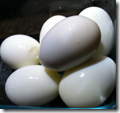 1. Egg Whites: Eggs are typically good breakfast foods. A boiled egg is only 70 calories, and a boiled egg without the yolk is only 15 calories!! You can eat 5 or 6 egg whites for breakfast while only using up 100 calories of your limit. I like to eat it with some salt or with a tablespoon of soy sauce (10 calories).
1. Egg Whites: Eggs are typically good breakfast foods. A boiled egg is only 70 calories, and a boiled egg without the yolk is only 15 calories!! You can eat 5 or 6 egg whites for breakfast while only using up 100 calories of your limit. I like to eat it with some salt or with a tablespoon of soy sauce (10 calories).
2. Protein Shakes: Another good option for breakfast is protein shakes. It’s easy and quick to make and you can get a large variety of different flavors. I like to make a simple one with 1.5 scoops of protein powder and 1/4 cup of milk or coconut milk with 8 oz of water. That’s 200 calories for the whole thing.
Snacks:
1. Low Calorie Cheeses: Luckily for us, Laughing Cow makes some tasty low calorie cheeses that are individually packaged in bite-size portions. The 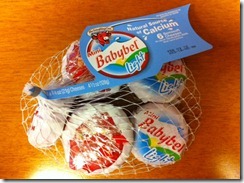
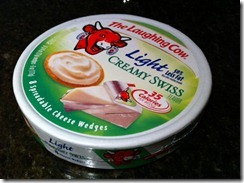 Babybel Light is 50 calories per piece (21 grams) and reminiscent of an unaged Gouda, and the Cream Swiss Light is a really a soft cheese spread that tastes very creamy, especially considering that each 21 gram wedge is only 35 calories.
Babybel Light is 50 calories per piece (21 grams) and reminiscent of an unaged Gouda, and the Cream Swiss Light is a really a soft cheese spread that tastes very creamy, especially considering that each 21 gram wedge is only 35 calories.
2. Apples and Berries: A medium sized apple with skin is around 80 calories and a cup of strawberries is around 45 calories.
3. Vegetable Sticks: Celery and zucchini are your best friends (close relatives like squash work perfectly too)! I think you can pretty much discard any calories from celery and an entire medium-sized zucchini is only 30 calories. Maybe dip in some calorie free dressing (like the ones from Walden Farm, described more below). By the way, pickles and cucumbers are also super low in calories.
Lunch/Dinner:
1. Salad: Yes, I know you feel like a rabbit eating leaves everyday, but vegetables are undeniably low in calories and high in micronutrients. Be careful not to get vegetables like corn, potatoes, chickpeas or carrots in your salad as they can raise the calories in your salad very quickly. Zucchini squash is one of my favorite things to put into a salad. One cup of sliced zucchini is only 30 calories! I find a few olives can also add a lot of flavor to the salad, although too many olives can hike up the calorie count too.
2. Salad Dressing: Low calorie dressings are hard to come by. A tablespoon of olive oil is 120 calories. I’ve always found that fact really depressing, since good olive oil makes the salad taste so much better to me. Walden Farms makes a line of calorie free dressings, but not all of them taste great. The Raspberry Vinaigrette seems to be a good safe option.
3. Grilled Salmon or Chicken: A 5oz salmon fillet is only 250 calories. You can eat it in your salad or by itself with some mustard (pretty much 0 calories) or calorie free hot sauce (I like Crystal Hot Sauce). Soy sauce, as usual, is also a good condiment to add some flavor without adding many calories. Grilled chicken is also low in calories, especially if you get it without the skin. A 5oz skinless piece of chicken breast is 150 calories. In fact, you can cook both the salmon and the chicken yourself easily on a grill (or simple, small, and cheap Foreman Grill if you’re in an apartment), and take it for your lunch.
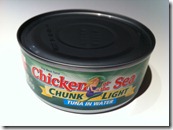 4. Tuna Salad: There are various tuna salads – you can buy them or you can make them. A can of tuna is 5oz and 100 calories and is packed with protein. I’m going to put up my favorite tuna salad recipe later this week.
4. Tuna Salad: There are various tuna salads – you can buy them or you can make them. A can of tuna is 5oz and 100 calories and is packed with protein. I’m going to put up my favorite tuna salad recipe later this week.
5: Deli Turkey Slices: I know what you’re thinking – slices of turkey meat doesn’t sound great by itself as a meal. But, it sounds more appetizing if served as part of a meat plate with some Babybel cheese, a bit of pickles, and maybe a few grapes or olives. A whole pound of Boars Head Mesquite turkey deli meat is only 480 calories, and I know I can’t eat a whole pound in one go! Like tuna, turkey is almost entirely protein.
6. Low Calorie Noodles: I wrote a post a back in August on Low Carb Pasta, and the great thing is that all those pastas were low calorie as well as low carb. Shirataki noodles (or Miracle noodles) have 0 calories and zucchini noodles are 20 calories per cup so you can eat both to your heart’s content.
Drinks
1. Diet Sodas: Obviously diet sodas have no calories, and there’s a huge variety. Be careful, though, if you find that the diet sodas make you hungrier. I personally like Vitamin Water Zero . There are also several drinks out now sweetened with Stevia instead of other artificial sweeteners.
2. Chicken Broth: This is seriously low calorie and makes me feel like I’m not just drinking water. A cup of chicken broth is just 10 calories (it varies slightly from brand to brand).
3. Almond milk: A cup of normal fat-free milk is 90 calories, but a cup of almond milk is just 40 calories, and it tastes pretty good in my opinion. It’s also good to put into protein shakes instead of milk. Just make sure you buy the unsweetened variety (it doesn’t matter if you get the original or the vanilla flavor as they both taste pretty much the same).
4. Tea and coffee: Of course, tea and coffee are both also calorie-free as long as you don’t add any milk or sugar into them.
5. Water: Remember to drink plenty of water!!!
Must I Exercise?
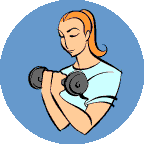 This is an entirely different post, but while I’m talking about shedding fat and counting calories, I feel like I should mention it. Unfortunately, our bodies are not as selective as we might like about whether to lose fat or muscle, so in order to lose more fat and less muscle, you should definitely put in some exercise. But don’t worry – it doesn’t need to be extremely time-consuming. No running or aerobic exercise is required (although a bit doesn’t hurt). You also don’t need to join an expensive gym or buy hardly any equipment (unless of course you want to seriously build some muscle!). Start light – buy a 5lb weight and just do some gentle arm curls with it. You can also do some push ups (do push ups against the wall to start with), sit ups/crunches, and squats. Try doing this for 15 to 20 minutes 3 times a week.
This is an entirely different post, but while I’m talking about shedding fat and counting calories, I feel like I should mention it. Unfortunately, our bodies are not as selective as we might like about whether to lose fat or muscle, so in order to lose more fat and less muscle, you should definitely put in some exercise. But don’t worry – it doesn’t need to be extremely time-consuming. No running or aerobic exercise is required (although a bit doesn’t hurt). You also don’t need to join an expensive gym or buy hardly any equipment (unless of course you want to seriously build some muscle!). Start light – buy a 5lb weight and just do some gentle arm curls with it. You can also do some push ups (do push ups against the wall to start with), sit ups/crunches, and squats. Try doing this for 15 to 20 minutes 3 times a week.
When Does the Diet End?
Although eating low carb is more of a lifestyle than a diet, counting calories thankfully need not last very long (personally, I’ll probably eat enough at Christmas to need to start all over…). Try going low calorie and low carb for 2-3 weeks and see what results you get. Don’t get discouraged if you end up cheating one day – just start again the next day. It’s too easy just to give up immediately if you stress out and eat badly one day. In fact, you can counteract the extra calories eaten during one day by eating less the next day (your body doesn’t necessarily work on 24-hour cycles). Remember, this is not a permanent lifestyle change, and you can convince yourself to do anything for 2-3 weeks!
